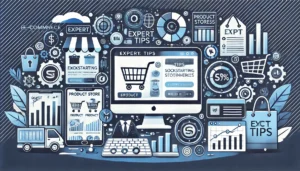Table of Contents
When it comes to running an online business, there is little room for errors. If you’re a smaller organization, this can prove problematic because you often don’t have many spare resources or time. So, what can you do to improve your service offering cost-effectively?
You have a couple of options. One is ecommerce customer service outsourcing. With this option, you hire a team to deal with support on your behalf. It’s a viable option, but it might prove too much in the earlier stages of your business.
You can also use software to augment the service you deliver. In this post, we’ll look at what you should look for in a program.
Ease of Use and User Interface
The software should have an intuitive user interface that makes it easy for you to manage products, orders, customers, and other essential aspects of your online store.
It’s a bonus if it has:
- A user-friendly dashboard
- Customizable layouts
- Drag-and-drop functionality for easy website customization.
Mobile Responsiveness
Your ecommerce store must display well across a range of devices, particularly mobile ones. Look for software that offers mobile-friendly templates and responsive design features.
You need to ensure seamless browsing and shopping experiences across all devices, including smartphones and tablets.
Customization and Flexibility
Every ecommerce business is unique, with specific branding requirements, product offerings, and customer preferences. Therefore, it makes sense to work with a product that allows a high level of customization.
What’s more, it should be easy to change features without needing to know anything about coding.
You’ll need to tailor the layout, fonts, design, and functionality so they align with your goals and complement your brand image.
Scalability and Performance
You need something that can grow as you do. It’s useful to have a tiered price structure that allows you to save money in the early stages. You need to make sure you can easily scale up due to:
- Increased traffic
- A bigger product catalog size
- Higher transaction volumes.
Look for ecommerce software that offers features such as cloud hosting and auto-scaling capabilities. You should also look for performance optimization tools to ensure fast page load times and minimal downtime during peak traffic periods.
Integration Capabilities
When considering different products, look at what software you can use them with. Are there plug-ins you can add or extra extensions? You’ll need to:
- Integrate with payment gateways
- Connect to shipping carriers
- Have reliable inventory management systems
- Access accounting software
- Incorporate marketing platforms
- Hook up to customer relationship management tools
Look into online reviews to see how the different programs work together. Do they overload the system, making your site load more slowly? If so, you need to find an alternative.
Payment Gateway Options
You should find software that will support multiple payment gateways to offer your customers various payment options at checkout.
You don’t have to offer every type, but do have the most common ones like:
- Credit/debit cards
- Digital wallets
- Bank transfers
- Paypal
You should make sure that the payment gateway integration is secure, PCI-compliant, and supports encryption for sensitive financial information.
Inventory Management
If you’re starting to pick up more orders, it becomes critical for you to manage your inventory carefully. Make sure that the software you choose can help with this. It would be great if it could help you track supplies, stock, and manage orders.
You could look into
- Real-time inventory tracking
- Low-stock alerts
- Backorder management and
- Batch editing capabilities
This system should integrate flawlessly with your website so that clients know if a product is out of stock or not.
Security and Compliance
Today, there are no excuses for being lax when it comes to your customer’s data. If there’s a breach and you’re found negligent, you can face severe financial penalties. The damage to your reputation can be even more severe.
You must ensure that any software you use adheres to the highest standards. It must be compliant with any regulations in all the areas that you serve. You should look for products that adhere to PCI DSS (Payment Card Industry Data Security Standard) and GDPR (General Data Protection Regulation).
Also, look for features like:
- SSL encryption
- Secure payment processing
- Data encryption
- Regular security updates
Customer Support and Documentation
You need a reliable customer support center to resolve issues, troubleshoot technical problems, and provide time assistance. When choosing your ecommerce software, look for something that facilitates a high level of communication.
Ideally, it should make it easy to connect through multiple channels such as live chat, email, and phone.
Some software may also incorporate simple chatbots that can answer FAQs or guide clients to the area of your knowledge base where they can find the information.
Cost and Pricing Structure
Finally, you need to consider the cost and pricing structure of the ecommerce software, including:
- Setup fees
- Monthly subscriptions
- Transaction fees
- Additional charges for premium features or add-ons.
Don’t just look at the initial offering; also consider what happens if you have to upgrade later. Many companies offer very appealing basic packages and then make their money with upgrades.
It may be better to start with a more moderately priced plan that offers a smaller increase at higher levels than a cheap one that has a massive increase.
You also need to consider what you’re getting for the money. Does the plan you’re considering offer all the features that you need? Does it offer many features you’ll never use?
You should be careful not to get caught out by a flashy product. If you do, you might end up paying a premium and not using half the features.
Conclusion
When it comes to selecting the right ecommerce software, there are many things to consider. You have to consider how easy it is to use, how well you can integrate it with other applications, and if you’re getting good value for your money.
It’s worth performing a good deal of research before settling on one product. That way, you can be sure of the right fit.







